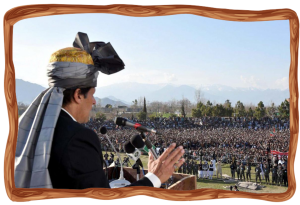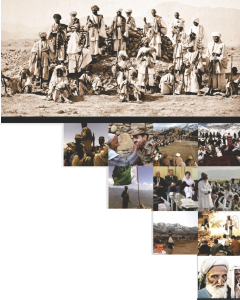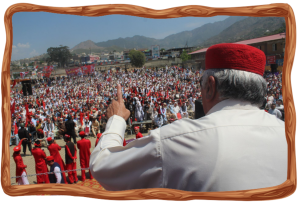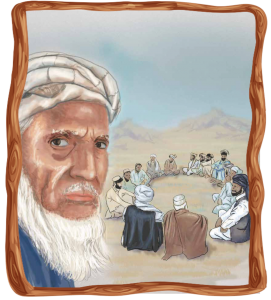FATA’s
Merger with
KP
Part II
Prospects, Challenges and
Opportunities
 Associated with the political will is the need for an unwavering commitment to the provision of funds for the development of the merged districts. Initially, there was a willingness to spend 3% of the federal divisible pool for the socio-economic development of ex-FATA for a period of ten years. However, later on, some provinces expressed their concerns and asked the federal government for the revision of the ratio.
Associated with the political will is the need for an unwavering commitment to the provision of funds for the development of the merged districts. Initially, there was a willingness to spend 3% of the federal divisible pool for the socio-economic development of ex-FATA for a period of ten years. However, later on, some provinces expressed their concerns and asked the federal government for the revision of the ratio.
The provincial governments are led by different political parties that have divergent interests, and political approaches to the national issues. The funding needs to be consistent and predictable. So should be the national political will to ensure the seamless merger. It has to be understood that failure on this count has grave implications not only for the people of ex-FATA but also for peace, stability and security of the country.
Now that the merger has taken place and all the departments that fell under the control of the FATA Secretariat have been merged with the KP Secretariat, there are serious concerns about the capacity of the provincial government to address the challenge. One of the persistent objections to the 18th Constitutional Amendment that makes logical sense is that a major chunk of resources and administrative authority was devolved to the provinces without looking at the fact whether the provinces had the capacity to accept such an onerous undertaking. The result of such an exercise is that the provincial governments have the resources and greater administrative mandate but are constrained to perform due to inherent capacity bottlenecks.
 For a post-conflict reconstruction, the participation of the community is the key. Erstwhile FATA was governed by archaic laws and repressive governance model that kept the people politically disempowered. Even the adult franchise was introduced in FATA in 1996. Despite the promulgation of the Political Parties Act (PPA) in 2011, independent MNAs continued to be elected. It has to be understood that political evolution is always a slow process. The grooming of local leaders will take time. It is here that the political parties must play a positive role in encouraging the local leaders and strengthening the local institutions to become instruments of change.
For a post-conflict reconstruction, the participation of the community is the key. Erstwhile FATA was governed by archaic laws and repressive governance model that kept the people politically disempowered. Even the adult franchise was introduced in FATA in 1996. Despite the promulgation of the Political Parties Act (PPA) in 2011, independent MNAs continued to be elected. It has to be understood that political evolution is always a slow process. The grooming of local leaders will take time. It is here that the political parties must play a positive role in encouraging the local leaders and strengthening the local institutions to become instruments of change.
The idea of utilizing 30% of ADP funds through local government institutions is praiseworthy. However, it requires that LG institutions are empowered politically and administratively to implement the development schemes that benefit the community. There are certainly issues with regard to the delimitation of constituencies, and the operationalisation of local councils, etc. The political parties must sit with the Election Commission to sort them out.
 The abolishment of FCR is certainly a watershed that did away with the draconian legal structure. The new legal reforms that replaced FCR have been received well. However, the legal experts have identified some flaws and loopholes in them that can undermine the promise of these reforms.
The abolishment of FCR is certainly a watershed that did away with the draconian legal structure. The new legal reforms that replaced FCR have been received well. However, the legal experts have identified some flaws and loopholes in them that can undermine the promise of these reforms.
Although Peshawar High Court declared it null and void, yet the decision whether to retain these centres or try the internees under the normal judicial system is still pending. Under the Criminal Procedure Code and Anti-Terrorism Act, 1997, the accused can be convicted subject to the submission of strong evidence and witnesses’ testimony. The same applies to those accused of terrorism and heinous crimes such as jet black terrorists. The law- enforcement personnel such as Khasaadars do not have the requisite qualifications to become part of the police apparatus. Above all, the demands of the people that the current judicial system will provide them swift, affordable justice will have to be met.
Changing the social culture and habits of the people is always a hard task. Encouraging people to pay taxes will prove to be a herculean task, especially when they have been used to state subsidies. The vested interests are also likely to oppose the promulgation of customs and border laws and regulation of trade. The main thrust of reforms is to open up economic and educational opportunities for the youth in an effort to make them shun militancy, and join the mainstream. The militants are always lurking in the shadows looking for loopholes and opportunities that the failure of the government in delivering on its commitment can provide them.
Ex-FATA is home to vast precious natural resources such as gas, coal, copper, oil, and marble. Investment in tapping these resources can usher in an era of unprecedented progress that will significantly uplift the socio-economic conditions of the people and provide jobs to the local workforce.
 The land in the merged districts is a precious asset and suitable for vegetables, fruits and horticulture. The livestock sector can be developed in a more systematic and organized manner, for there are sufficient grazing areas that are complemented by favourable weather conditions. Agriculture, forestry and livestock sectors are ripe for gainful investment and have the potential to cater to the local workforce. In order to maximize the output, and increase productivity, the government can launch awareness projects for the local farming community, educating them about the modern irrigation techniques and livestock development methods.
The land in the merged districts is a precious asset and suitable for vegetables, fruits and horticulture. The livestock sector can be developed in a more systematic and organized manner, for there are sufficient grazing areas that are complemented by favourable weather conditions. Agriculture, forestry and livestock sectors are ripe for gainful investment and have the potential to cater to the local workforce. In order to maximize the output, and increase productivity, the government can launch awareness projects for the local farming community, educating them about the modern irrigation techniques and livestock development methods.
Ex-FATA has the potential to become a trade and tourism hub. Existing trade facilities can be strengthened by developing trade routes such as Terri-Mangal, Kharlaachi, Ghulam Khan and Angoor Adda on the lines of Torkham. However, for the merged districts to become attractive trade and tourism spots, the government needs to invest in developing the requisite infrastructure, ensure peace and security and introduce tourism-friendly policies by learning from the best models.
As explained earlier, the merged districts are the gateway to Afghanistan and the Central Asian Republics. If Pakistan and Afghanistan can overcome their differences and forge a more peaceful, cooperative relationship, the shared economic opportunities they will unlock can be instrumental in changing the fate of erstwhile FATA. Such a prospect seems to be in sight after the signing of the peace deal between the US and Taliban and resumption of intra-Afghan dialogue. Given their strategic location, both the brotherly nations can increase the volume of their bilateral trade by $5 billion annually.
Erstwhile FATA has suffered the scourge of terrorism and militancy since the Soviet invasion of Afghanistan. Its geo-strategic location, being a next-door neighbour to Afghanistan, has been its greatest disadvantage. If the merger becomes successful and a semblance of peace and normalcy returns to Afghanistan, it can deal a decisive blow to the forces of terrorism. Once people stand to gain from the reforms, they will become the biggest stakeholder and partner in peace and development. Such a scenario will ring a death knell to the transnational terrorist organizations such as Al-Qaeda and Islamic State.
The 25th Constitutional Amendment that altered the constitutional position of FATA by merging it with KP is no doubt a step of epic significance. However, the mainstreaming enterprise can be a challenging undertaking as a lot depends on the implementation of several factors including sustained political will on the part of the stakeholders. It has to be kept in mind that the people of former FATA are greatly invested in the merger process as they look at it as a passport to better socio-economic conditions and significant transformation in their lives. It is a national project where the cost of failure will be enormous.
This brings us to the need for setting up a monitoring body to oversee the process of merger of ex-FATA with the KP. The need for such a body to be manned by representatives of all stakeholders arises from the fact that the process is a time-taking exercise and the differences are sure to crop up along the way. The mandate of this body should be to iron out differences and provide strategic guidance.
The role of local government institutions for effective service delivery is well-documented all over the world. The local government institutions provide the foundation on which the edifice of democracy is erected. The LG system allows people a say in the decision-making on matters that are directly related to them and thus they create greater ownership of the democratic project.
A regular process of holding local bodies elections in a transparent manner will result in the emergence of local leadership, one that understands the problems facing the people of the merged districts. The political parties must raise a voice for the introduction of local government system in the merged districts and urge the Election Commission to complete all modalities such as the delimitation of the constituencies. The provision of municipal services to the people will not only improve socio-economic conditions but will also inspire hope and confidence in them. Together with the establishment of Tehsil municipalities, the operationalization of the local councils holds the key to the provision of basic services to the people at their doorsteps.
The introduction of the formal justice system and the abolishment of fear-inducing FCR in former FATA is a core item in the overall reform package. A lot hinges on the success of this initiative as people need to be assured that the provision of justice will be prompt, even-handed and cheap. There is a need to enact a saving clause to the Constitutional Amendment in order to ramp up the prosecution of all cases registered under FCR until May 30, 2018. However, in order to try the jet-black terrorists, militants and hardened criminals, an option of military courts with a sun-set clause can be explored.
As the formal policing system has come into force in the merged districts, Levis and Khasadars may be dismantled in a phased manner through measures such as golden handshake schemes. Those manning this force do not have the requisite educational qualifications, training and even aptitude to become part of modern-day policing.
Dealing with militancy and extremism is a long-term project. The state needs to invest its material and intellectual resources to develop a locally customized de-radicalization strategy with the input of all concerned. The world’s best practices can be included as well. Curing the diseased militant mindset is critical to the establishment of sustainable peace in the merged districts.
The private sector is the engine of growth. Given erstwhile FATA’s massive development lag, there is an enormous need for involving the private sector. This objective can be attained by introducing incentives, and attractive investment policy. A sustained publicity and promotion campaign can be developed by the government to highlight the untapped opportunities and business potential in the trade and tourism sectors. A public-private partnership model can be adopted to invite the private sector to invest particularly in the fields of health and education.
Land is considered a precious asset anywhere, particularly in erstwhile FATA that has few means of income generation. Therefore, it is important that the issues related to land titles are resolved. The KP revenue department may consult Punjab Lands Records Authority (PLRA) to institute a lands record management and information system (LRMIS). The danger is that the lingering land disputes may not only result in violence but can also erode the spirit of the merger.
 Funding remains critical to the success of the reforms in erstwhile FATA. The reservations of some provinces on their commitment to allocate 3 percent from the federal divisible pool, which is roughly Rs. 100 to Rs. 120 billion, augurs ill for the fruition of reform efforts. Availability of funds either through a share of NFC or ADP needs to be ensured to end the socio-economic backwardness of the merged districts. The projects that are part of Accelerated Implementation Plan (AIP) need to be benchmarked with clear start and end dates. Additionally, the establishment of the Development Monitoring Unit (DMU) may be considered with an express aim to oversee utilization of funds, and the completion of the projects within allotted timelines through strict surveillance.
Funding remains critical to the success of the reforms in erstwhile FATA. The reservations of some provinces on their commitment to allocate 3 percent from the federal divisible pool, which is roughly Rs. 100 to Rs. 120 billion, augurs ill for the fruition of reform efforts. Availability of funds either through a share of NFC or ADP needs to be ensured to end the socio-economic backwardness of the merged districts. The projects that are part of Accelerated Implementation Plan (AIP) need to be benchmarked with clear start and end dates. Additionally, the establishment of the Development Monitoring Unit (DMU) may be considered with an express aim to oversee utilization of funds, and the completion of the projects within allotted timelines through strict surveillance.
Though the government has given tax holiday of five years to former FATA to attract businessmen, a lot more needs to be done and it includes increasing the tax break period to ten years, the announcement of an incentive package for SMEs, the provision of enabling environment such as the building of requisite infrastructure and introduction of formal banking services in the merged districts.
The merger of FATA with the KP province, thanks to the 25th Constitutional Amendment, is certainly an epoch-making development. It has not only addressed the long-standing demand of the tribal people but also raised expectations of a better life. The geo-strategic location and history of FATA particularly after the events of 9/11 made it abundantly clear to the political and military leadership that the legal, political, economic and administrative reforms in FATA had become an absolute necessity. It was concluded after successive military operations that the path to peace in mainland Pakistan passed through FATA and that the status quo was no more sustainable.
The merger, however, presents a complex public policy challenge. The post-conflict reconstruction is never a smooth affair, necessitating the imperative of security, participation, governance and improvement in the conditions of the people. If implemented in letter and spirit, the reforms in legal, political, economic and social domains can lift the living standards of the people. However, it requires that people of the merged districts are included in the decision-making through local government institutions.
The writer, a Chevening scholar, and has studied International Journalism at the University of Sussex. He is a regular contributor to The News.
Email: amanatchpk@gmail.com
Twitter: @Amanat222
 Jahangir's World Times First Comprehensive Magazine for students/teachers of competitive exams and general readers as well.
Jahangir's World Times First Comprehensive Magazine for students/teachers of competitive exams and general readers as well.


